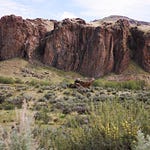A story about following a coyote’s tracks in fresh snow. And, in turn, thinking about my own life. Full text below.
Piano and story by me, Hudson Gardner. Tracks by coyote and deer. Snow by earth.
…
At the base of the hill, past the muddy shopyard and cattle fences, across the bridge that planks over Chimacum creek, and just before the salmonberry groves, were two perfect prints in the fresh snow.
Light snow filled in the almond shaped grooves, with the gradually tapering tips softened by fresh flakes that fell overnight.
The tracks were staggered, by just a few inches, almost one atop another. About an inch long, they went nearly through to the dark ground. They were the tracks of a young black tailed deer.
We followed them, leading away from the road, down a path through a low boggy area where gravel had been spread in late summer. Halfway through the bog, the tracks met a coyotes—coming the opposite direction. Though the coyotes were fresh: not hours, maybe not even minutes ago had his-her warm breathing body passed this spot. So we followed the tracks, one going forward, one backward, and read the animals stories.
Late in the night the deer had been walking north. Early this morning, the coyote was headed south. At one point, the deer tracks split and headed west, into a thick cedar bog. The coyotes backtracks continued clearly up the hill.
The coyote showed a habit of winding around, following their nose. A shuffling around spot in the snow revealed a hole down to bare grass, where the coyote had ambushed a rodent in their track.
Further up the hill the coyote had deviated from the main line of path, heading into a field. Another hole, another rodent crunched. That brought the count to at least two rodents for breakfast, probably in the space of less than five minutes.
Around an alder copse the tracks went, then to a little rise in the ground. And then they stopped.
There was a little circle of melted snow and ice, where they coyote had, at some point late last night, curled up to sleep. And beyond that little circle, a path of older tracks led away into the distance, marking where he-she had come from.
Standing, looking at this little place of rest, the choice made no sense. It was open on all sides, with no tree cover. But the longer I looked, the more I realized how perfect of a place it was. The grass all around was flattened, giving good sight lines in all directions. By barely lifting his-her head, the coyote could see hundreds of yards in all directions. Yet, due to their location on the small rise, they couldn't be seen until they either heard someone approaching, or saw them. It may have been the most protected place, as far as sight lines and escape routes, in a square mile of hills, forest, and bog.
From the little melted circle of rest, the coyote's tracks led into the distance, toward a farm house and a few hills. Beyond there, I knew that a lake lay, and somewhat remote young forests interspersed with clearcuts. The coyote may have come all the way from up there, or he-she may spend a lot of time in this field, hunting the plentiful voles and mice. I would never have known this story, but for the rare snow that told it to me.
Following this track in the snow got me thinking about my own story. I set out a while ago to write in a way that was like a river: vital, ever moving, multi branched, yet still knowable. Formed, and form-ing, ever changing, never staying the same, yet having some sense to it. I wanted to write like that. And in learning to write that way my life itself has inevitably taken course changes.
Life always seems hazy to me, a constant process of testing. And yet there are these crystalline moments, where it seems like everything has led somewhere that it all makes sense, like how a river always has a source. Yet just as that feeling is grasped, the solidity and good feelings tend to dissolve again.
I wonder if there are more trails I can follow, larger than my own knowing. To be supported by, yet not be exploited by. Such things make me think of my best times. I think of when I have felt understood, or made something worth understanding. And like I told someone recently, these crystalline moments seem like little guide posts I have hammered into the ground as I've gone. And from some perfect place of rest, on a low hill, it may be possible to look back at them. And then to wake up, and keep on going.
...
That was backtracking, and I hope you enjoyed it.
You may notice in this episode that I avoided using the word "it" when referring to the deer and coyote. That is because the word "it" often refers to something inanimate, something without consciousness. I don't believe animals lack consciousness, I believe they feel things just as we do—have memories, stories, and lives—so I prefer to use the word "he-she" when I don't know their gender, or "they" instead of "it". Just something to think about.
I love you. Take care
— Hudson













